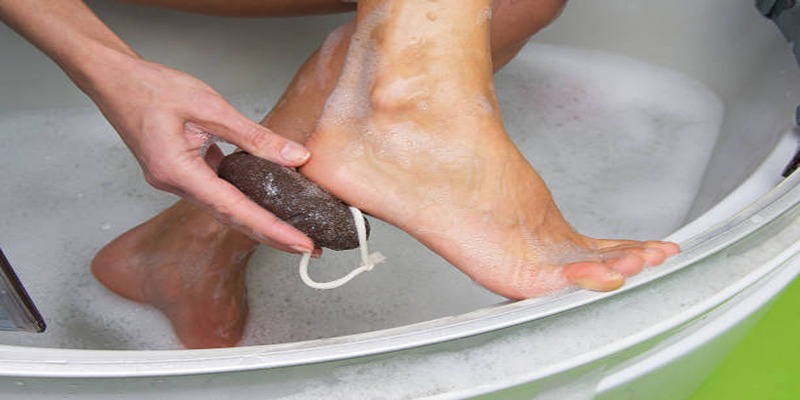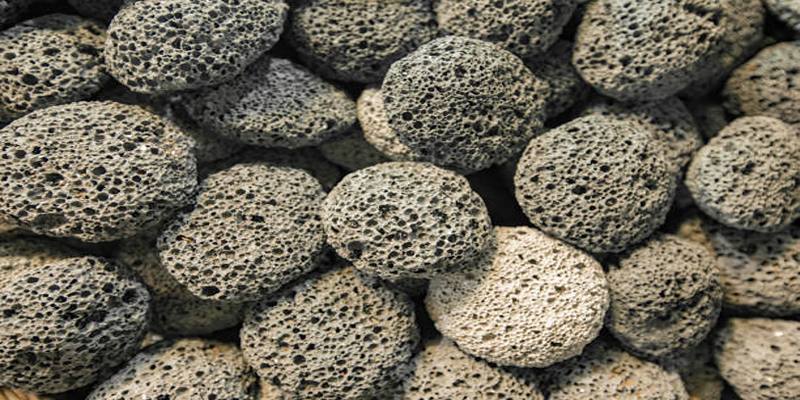Mastering the Art of Foot Care: Using a Pumice Stone for Soft Feet
Aug 21, 2024 By Kristina Cappetta
Maintaining healthy and soft feet is essential for overall well-being, as they carry us through our daily activities and bear the weight of our bodies. One effective and accessible method to achieve this is by using a pumice stone. This naturally occurring volcanic rock has been a staple in foot care for centuries, prized for its ability to gently exfoliate rough, calloused skin. By incorporating a pumice stone into your routine, not only can you enhance the appearance of your feet, but you can also promote better foot hygiene and prevent various conditions such as corns and calluses. In this guide, well explore the benefits of using a pumice stone, offer step-by-step instructions on its application, and share tips for maintaining soft, healthy feet that feel as good as they look.
What is a Pumice Stone?

A pumice stone is a lightweight, porous volcanic rock formed when lava cools and depressurises rapidly. Its unique texture, characterised by many tiny air pockets, gives it excellent exfoliating properties, making it an ideal tool for removing dead skin and calluses on the feet. Pumice stones are commonly used in beauty and foot care routines due to their ability to gently buff away rough patches without causing irritation.
Different Types of Pumice Stones Available
When selecting a pumice stone for foot care, its important to consider the various types available, each designed for specific needs.
- Natural Pumice Stones: These are the classic options, sourced directly from volcanic rock. They come in different shapes and sizes, providing a variety of textures that can cater to individual preferences. Natural pumice stones typically have a rougher surface that effectively exfoliates thick calluses.
- Synthetic Pumice Stones: Often made from a blend of pumice and other materials, synthetic stones can be engineered for finer exfoliation. They tend to be more consistent in texture and can come in various colours and designs.
- Pumice Stone with Handle: These stones come attached to a handle, providing better grip and control during use. They are especially useful for reaching difficult areas of the feet, making them a great option for individuals with limited flexibility.
- Foot Files with Pumice Surface: Combining the elements of a pumice stone and a foot file, these tools often feature a coarse surface for tougher skin and a smoother side for gentle exfoliation. They are versatile and can be effective for multiple foot care purposes.
- Pumice Stones Infused with Skin Care Ingredients: Some pumice stones are designed with added benefits, such as infused oils or exfoliants that release during use. These can enhance hydration and provide additional softness to the skin while exfoliating.
Each type of pumice stone serves a unique purpose, allowing you to choose the one that best suits your foot care routine and skin type.
How to Use a Pumice Stone?
Using a pumice stone is a straightforward process that can significantly enhance your foot care routine. Follow these simple steps to achieve soft, healthy feet:
- Soak Your Feet: Begin by soaking your feet in warm, soapy water for 10 to 15 minutes. This process softens the skin, facilitating the removal of dead skin and calluses. For added benefits, consider incorporating Epsom salt or essential oils into the soak.
- Dry Your Feet: After soaking, dry your feet thoroughly, paying special attention to the areas between your toes to prevent moisture build-up.
- Gently Exfoliate: Using the pumice stone, apply light pressure and gently rub it over the areas of rough or calloused skin in a circular motion. Focus on the heels, balls of the feet, and any other areas that feel particularly coarse. Avoid applying too much pressure, as this may irritate your skin.
- Rinse and Moisturise: Once youve exfoliated, rinse your feet under warm water to wash away any dead skin particles. Pat your feet dry and apply a high-quality foot cream or moisturiser to nourish and hydrate your skin.
- Clean Your Pumice Stone: After use, rinse your pumice stone under running water and allow it to air dry. This helps maintain its effectiveness and hygiene for future use.
- Frequency of Use: Incorporate pumice stone use into your regular foot care routine, ideally once a week, to help prevent the build-up of dead skin and maintain soft feet.
By following these steps, you'll be well on your way to enjoying the benefits of smooth, soft feet.
Benefits of Using a Pumice Stone
Incorporating a pumice stone into your foot care routine offers a multitude of benefits that contribute to both the health and aesthetic appeal of your feet.
- Exfoliation: The primary advantage of using a pumice stone is its ability to effectively exfoliate dead skin cells and calluses, revealing softer skin underneath. Regular use helps maintain smoothness and prevents the build-up of thick, rough patches.
- Enhanced Circulation: Gently rubbing the pumice stone over the feet can stimulate blood flow in the area, which is beneficial for overall foot health and can aid in the healing process of minor ailments.
- Prevention of Foot Problems: By regularly removing dead skin and calluses, pumice stones can help avert more severe foot issues, such as corns and plantar warts, ensuring that your feet remain healthy and free from discomfort.
- Improved Hygiene: Exfoliating with a pumice stone assists in keeping the feet clean by eliminating dirt, oil, and bacteria that can accumulate in rough skin, reducing the risk of infections.
- Promotes Relaxation: The process of using a pumice stone can be therapeutic, providing a relaxing experience that unwinds the feet after a long day. Coupled with warm water soaking, it creates a pampering self-care ritual.
Common Mistakes to Avoid

While using a pumice stone can greatly enhance your foot care routine, there are several common mistakes that can reduce its effectiveness or lead to skin irritation. Here are some pitfalls to watch out for:
- Using on Dry Skin: One of the biggest mistakes is attempting to exfoliate dry skin. Always soak your feet beforehand to soften the skin, as this makes the removal of dead skin cells easier and more effective.
- Applying Too Much Pressure: Many people believe that pressing hard on the pumice stone will yield better results. However, excessive pressure can cause irritation or even skin damage. Light, gentle strokes are sufficient for effective exfoliation.
- Neglecting to Clean the Pumice Stone: After each use, its essential to clean your pumice stone to prevent the build-up of bacteria and dead skin. Skipping this step can lead to skin infections or irritations.
- Over-Exfoliating: Using a pumice stone too frequently can strip the skin of its natural oils, leading to dryness and potential cracks. It's best to limit use to once a week, allowing the skin time to recover.
- Ignoring Moisturisation: After exfoliating, its crucial to apply a moisturiser to hydrate the feet. Failing to do so can lead to further dryness, counteracting the benefits of your exfoliation.
Aftercare Tips
Following your pumice stone treatment, proper aftercare is vital to ensure your feet remain soft, healthy, and hydrated. Here are some essential aftercare tips to keep in mind:
- Moisturise Regularly: After exfoliating, apply a nourishing foot cream or lotion to lock in moisture. Focus on the heels and balls of your feet, as these areas tend to dry out quickly. Look for products containing ingredients like shea butter, coconut oil, or aloe vera for optimal hydration.
- Wear Comfortable Footwear: Choose well-fitting shoes that provide support and allow your feet to breathe. Avoid tight or restrictive footwear, as this can lead to discomfort and hinder the healing process of your skin after exfoliation.
- Stay Hydrated: Drinking plenty of water throughout the day helps maintain overall skin hydration, including your feet. Staying hydrated can significantly improve skin elasticity and health.
- Monitor Changes: Regularly inspect your feet for any changes or signs of irritation. If you notice persistent redness, cracks, or other issues, consult a healthcare professional for advice.
Final Thoughts
Incorporating a pumice stone into your foot care routine can significantly enhance the health and appearance of your feet. By following the proper techniques and addressing common mistakes, you can enjoy the myriad benefits, from smoother skin to improved hygiene. Remember to complement your exfoliation with regular moisturisation and mindful aftercare to maintain the softness and overall wellbeing of your feet.

Kombucha: 5 Powerful Health Benefits of This Probiotic-Rich Beverage
Home Gardening Made Easy: Benalla’s Guide to Growing Your Own Produce

Liquid Calories: What You Must Know

Discovering Squat Variations: 7 Alternatives to Barbell Squats

Fitness Hacks, Recommended By Personal Trainers:

What Causes Tendinitis and How Can You Find Relief?

Atrial Fibrillation: Common Causes, Symptoms, Treatment, And More

Essential Guide to Resuming Exercise Postpartum with Assurance and Vigor

Unveiling the Secrets to Weight Loss and Heart Health

Meditation in Motion: Ways to Find Peace Without Sitting Still

Pull-up Breathing techniques: A Guide to Proper Technique
